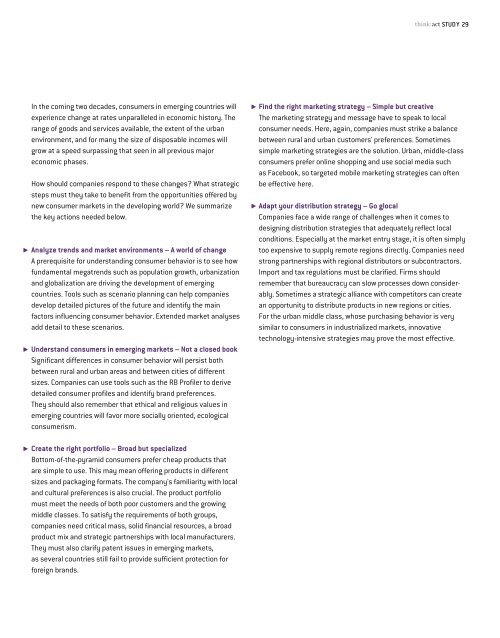How to reach emerging market consumers with new ... - Roland Berger
How to reach emerging market consumers with new ... - Roland Berger
How to reach emerging market consumers with new ... - Roland Berger
Create successful ePaper yourself
Turn your PDF publications into a flip-book with our unique Google optimized e-Paper software.
Study 29<br />
In the coming two decades, <strong>consumers</strong> in <strong>emerging</strong> countries will<br />
experience change at rates unparalleled in economic his<strong>to</strong>ry. The<br />
range of goods and services available, the extent of the urban<br />
environment, and for many the size of disposable incomes will<br />
grow at a speed surpassing that seen in all previous major<br />
economic phases.<br />
<strong>How</strong> should companies respond <strong>to</strong> these changes? What strategic<br />
steps must they take <strong>to</strong> benefit from the opportunities offered by<br />
<strong>new</strong> consumer <strong>market</strong>s in the developing world? We summarize<br />
the key actions needed below.<br />
Analyze trends and <strong>market</strong> environments – A world of change<br />
A prerequisite for understanding consumer behavior is <strong>to</strong> see how<br />
fundamental megatrends such as population growth, urbanization<br />
and globalization are driving the development of <strong>emerging</strong><br />
countries. Tools such as scenario planning can help companies<br />
develop detailed pictures of the future and identify the main<br />
fac<strong>to</strong>rs influencing consumer behavior. Extended <strong>market</strong> analyses<br />
add detail <strong>to</strong> these scenarios.<br />
Understand <strong>consumers</strong> in <strong>emerging</strong> <strong>market</strong>s – Not a closed book<br />
Significant differences in consumer behavior will persist both<br />
between rural and urban areas and between cities of different<br />
sizes. Companies can use <strong>to</strong>ols such as the RB Profiler <strong>to</strong> derive<br />
detailed consumer profiles and identify brand preferences.<br />
They should also remember that ethical and religious values in<br />
<strong>emerging</strong> countries will favor more socially oriented, ecological<br />
consumerism.<br />
Find the right <strong>market</strong>ing strategy – Simple but creative<br />
The <strong>market</strong>ing strategy and message have <strong>to</strong> speak <strong>to</strong> local<br />
consumer needs. Here, again, companies must strike a balance<br />
between rural and urban cus<strong>to</strong>mers' preferences. Sometimes<br />
simple <strong>market</strong>ing strategies are the solution. Urban, middle-class<br />
<strong>consumers</strong> prefer online shopping and use social media such<br />
as Facebook, so targeted mobile <strong>market</strong>ing strategies can often<br />
be effective here.<br />
Adapt your distribution strategy – Go glocal<br />
Companies face a wide range of challenges when it comes <strong>to</strong><br />
designing distribution strategies that adequately reflect local<br />
conditions. Especially at the <strong>market</strong> entry stage, it is often simply<br />
<strong>to</strong>o expensive <strong>to</strong> supply remote regions directly. Companies need<br />
strong partnerships <strong>with</strong> regional distribu<strong>to</strong>rs or subcontrac<strong>to</strong>rs.<br />
Import and tax regulations must be clarified. Firms should<br />
re member that bureaucracy can slow processes down con siderably.<br />
Sometimes a strategic alliance <strong>with</strong> competi<strong>to</strong>rs can create<br />
an opportunity <strong>to</strong> distribute products in <strong>new</strong> regions or cities.<br />
For the urban middle class, whose purchasing behavior is very<br />
similar <strong>to</strong> <strong>consumers</strong> in industrialized <strong>market</strong>s, innovative<br />
technology-intensive strategies may prove the most effective.<br />
Create the right portfolio – Broad but specialized<br />
Bot<strong>to</strong>m-of-the-pyramid <strong>consumers</strong> prefer cheap products that<br />
are simple <strong>to</strong> use. This may mean offering products in different<br />
sizes and packaging formats. The company's familiarity <strong>with</strong> local<br />
and cultural preferences is also crucial. The product portfolio<br />
must meet the needs of both poor cus<strong>to</strong>mers and the growing<br />
middle classes. To satisfy the requirements of both groups,<br />
companies need critical mass, solid financial resources, a broad<br />
product mix and strategic partnerships <strong>with</strong> local manufacturers.<br />
They must also clarify patent issues in <strong>emerging</strong> <strong>market</strong>s,<br />
as several countries still fail <strong>to</strong> provide sufficient protection for<br />
foreign brands.
















